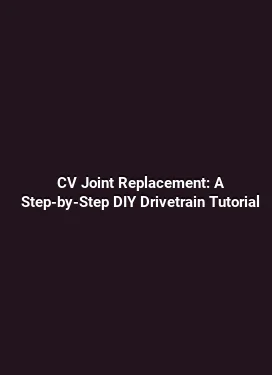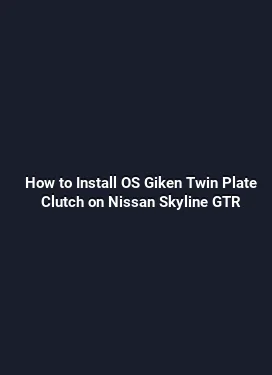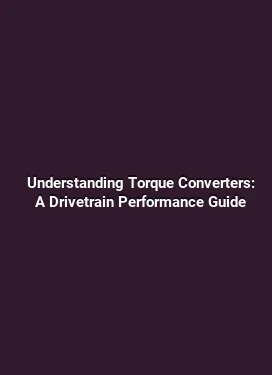Best Transmission Mounts: OEM vs Polyurethane vs Solid Mount
Understanding Transmission Mounts and Their Role in Drivetrain Performance

Transmission mounts are more than mere anchors holding the gearbox in place. They are critical components that influence how power is delivered to the wheels, how the engine and transmission respond to torque, and how comfortable a vehicle feels to drive. The mount’s primary job is to secure the transmission while isolating the surrounding chassis from vibration, allowing for smooth operation under a wide range of conditions. In performance applications, the choice of mount material and design can dramatically alter how quickly the drivetrain reacts to driver input, how much feedback the occupants perceive, and how well the system withstands high torque without compromising alignment.
When evaluating transmission mounts, several factors come into play: stiffness, damping, temperature resistance, and how the mount behaves under load when the engine torque changes rapidly. OEM mounts are designed for a balance of durability, comfort, and longevity across a broad spectrum of conditions. In contrast, aftermarket options like polyurethane and solid mounts emphasize distinct goals such as enhanced responsiveness or maximum load-bearing capacity. Understanding these trade-offs helps enthusiasts select mounts that align with their goals, whether that means a smoother daily ride or a track-ready chassis.
Types of Transmission Mounts: What Sets Them Apart
OEM Transmission Mounts: The Baseline for Everyday Driving

Original Equipment Manufacturer (OEM) mounts are engineered to deliver a balanced NVH (noise, vibration, and harshness) profile while maintaining reliable performance over the life of the vehicle. They use materials and geometries that cushion the drivetrain during normal operation, dampening the impact of engine torque as it transfers through the transmission. For most users, OEM mounts provide predictable behavior, simple maintenance, and compatibility with factory alignment specifications.
Key characteristics of OEM mounts include moderate stiffness, integrated damping elements, and coatings designed to resist heat and oil exposure typical of under-hood environments. The design frequently accommodates engine movement, slight misalignment, and vibration isolation to minimize cabin noise. This means OEM mounts often excel in everyday comfort and long-term reliability, with a focus on minimizing vibrations at cruising speeds and under light to moderate loads.
Polyurethane Transmission Mounts: A Balance Between Stiffness and Durability
Polyurethane mounts are a popular aftermarket option for enthusiasts seeking more precise throttle response and reduced drivetrain movement without venturing into extreme stiffness. Polyurethane has higher tear and wear resistance than many rubber compounds and maintains shape under higher loads, which helps keep the transmission aligned during aggressive shifting and cornering. The result is a drivetrain that feels more connected to the steering and throttle inputs, with quicker transmission of torque through the chassis.
With increased stiffness, polyurethane mounts can raise the transmission’s effective center of mass in relation to the engine, slightly increasing front-end feedback through the floor or pedals. This can improve shift feel and gear engagement under spirited driving or in performance-oriented builds. However, the trade-off is that cabin vibration and mechanical noise can become more noticeable, especially at lower speeds or on uneven road surfaces. Proper installation and a careful choice of durometer are essential to achieving the desired balance between control and comfort.
Solid Transmission Mounts: Maximum Rigidity for Specialty Applications
Solid mounts, often constructed from metals or dense composites, offer the highest stiffness and the least compliance compared to OEM rubber or polyurethane designs. They are favored in applications where drivetrain timing and alignment must be preserved with extreme precision, such as drag racing, high-torce builds, or track-focused street machines. By minimizing any drivetrain movement, solid mounts can improve throttle response, shift accuracy, and engine placement stability during rapid acceleration and high-load events.
Despite the performance advantages, solid mounts tend to transmit more vibrations to the chassis. This increased NVH can lead to a stiffer ride, higher cabin noise, and potential wear on adjacent components if the mounting system is not well integrated with the vehicle’s overall dynamics. For daily driving, a solid mount setup may feel harsh and require additional reinforcement or isolation strategies to maintain a practical balance between performance and comfort.
Practical Considerations: How to Choose the Right Mount for Your Vehicle
Assessing Your Goals: Daily Driving vs. Track-Ready Performance
Start with a clear objective. If the goal is comfortable daily driving with predictable behavior, OEM mounts or a well-chosen damping-enhanced aftermarket option provide a favorable blend of performance and comfort. For drivers seeking sharper throttle response and more direct gear engagement, polyurethane mounts offer a noticeable improvement in drivetrain behavior without completely sacrificing comfort. For competitive builds where every fraction of a second matters and the vehicle operates under high torque, solid mounts may be the best choice, provided the rest of the suspension and chassis are tuned to manage the increased NVH.
Vehicle weight, power output, and drivetrain layout influence mount performance. Heavier cars with high-torque engines place greater demands on mounts, potentially accelerating wear or shifting the balance of vibration through the chassis. In such cases, a carefully engineered polyurethane solution or a purpose-built solid mount with proper isolation where needed can yield the best results when paired with compatible bushings and crossmember hardware.
Torque Management and Mount Behavior Under Load
Mounts are most directly affected by how torque is transferred through the drivetrain. A mount that is too soft can allow excessive movement, leading to timing shift in gear engagement or misalignment over time. A mount that is too stiff can transmit high-frequency vibrations and increase chassis fatigue. In practical terms, this means evaluating how the mount behaves during peak torque when shifting, under abrupt throttle releases, and during weight transfer in cornering. A good approach is to examine dyno data or on-road feedback from drivers who run similar setups, noting any changes in shift feel, clutch engagement, or drivetrain noises that accompany different mount configurations.
Installation quality matters as well. Mounts that are not properly torqued, aligned, or secured can introduce additional misalignment and vibrations that obscure the true performance characteristics. Using high-quality fasteners, correct thread engagements, and following manufacturer torque specifications ensures the mount performs as intended and maintains alignment with the transmission tunnel and engine block.
Heat and Environment: How Harsh Conditions Influence Mount Longevity
Under-hood environments expose mounts to heat, oil, and coolant exposure. OEM designs account for these factors with protective coatings and resilient elastomer compounds. Polyurethane mounts use materials that resist aging but can become stiffer with prolonged heat exposure, potentially altering their dynamic response over time. Solid mounts, while very robust, must be engineered to prevent heat buildup and to avoid metal-to-metal contact that could lead to chatter or alignment drift. When selecting mounts, consider the vehicle’s geographic climate and typical operating temperatures, as well as service intervals that might affect mount longevity.
Installation and Tuning: Bringing It All Together
Installation Best Practices for Each Mount Type
OEM mounts are typically installed using standard factory procedures. It is crucial to ensure the engine and transmission are positioned correctly to avoid misalignment of the crossmember and driveshaft components. A clean mounting surface, proper lubrication of bolts, and torque values specified by the manufacturer help preserve the intended harmonics and vibration isolation characteristics.
Polyurethane mounts often require attention to corrosion protection on bracket surfaces and sometimes alternate fastener choices to accommodate different stiffness levels. It is common to see a slight increase in drivetrain noise after conversion, which can be mitigated through selective use of isolating bushings or additional dampening components in surrounding areas.
Solid mounts demand precise alignment and, in many setups, a reinforced subframe or bulkhead mount to prevent unwanted movement. Mounts should be torqued in a sequence that minimizes uneven loading, and gaps around the mount should be checked to ensure even contact across the mounting surface. A professional alignment check is advisable after installation to verify that the drivetrain remains within tolerance across a range of operating conditions.
Tuning Considerations: How to Optimize Ride and Response
After selecting a mount type, consider complementary components that influence how the drivetrain communicates with the chassis. Upgrading engine mounts, transmission mounts, or adding complementary damping elements in the subframe can help tailor the balance between responsiveness and comfort. In some builds, adjusting the exhaust system, suspension bushings, and chassis bracing can further refine how vibrations travel through the vehicle, reducing unwanted harmonics and improving overall feel without compromising reliability.
Test drives and methodical evaluation are essential. Take note of shift quality, throttle modulation, steering feedback, and cabin noise at various speeds and road surfaces. Documenting changes with each iteration provides a practical roadmap for achieving the desired compromise between stiffness, NVH, and durability.
Real-World Scenarios: Case Studies of Mount Choices
Case Study A: Daily Driver Upgrading to Performance Polyurethane
A compact sedan used for daily commuting with occasional weekend canyon runs underwent a polyurethane mount upgrade to reduce drivetrain movement. The driver reported crisper throttle response and quicker gear engagement, with a manageable increase in cabin vibration during low-speed urban driving. The installation included accompanying updates to engine mounts and minor suspension dampening adjustments to maintain overall ride quality.
Case Study B: Track-Focused Setup with Solid Transmission Mounts
A mid-engine sports car prepared for track days opted for solid transmission mounts to minimize drivetrain movement at peak torque. The result was enhanced shift precision and more stable alignment during rapid acceleration and braking. To keep cabin comfort reasonable, the setup was paired with upgraded chassis braces and throttle response tuning, ensuring that the increased NVH remained within acceptable limits for endurance sessions.
Case Study C: OEM Mounts in a Cold Climate Vehicle
In a vehicle frequently operating in low-temperature environments, OEM mounts were preferred to preserve a quiet cabin and long-term reliability. The decision factored in the consistent performance across seasons, with maintenance intervals extended to ensure elastomer integrity and connection points stayed within tolerance as temperatures fluctuated.
Maintenance and Longevity: Extending Mount Life
Inspection Routines and Early Warning Signs
Regular visual inspections for cracks, tears, or oil ingress can prevent sudden failures. Look for abnormal gaps, excessive movement during operation, or new rattles that appear under acceleration. Early signs of wear or misalignment should prompt a targeted inspection of the mounting hardware and adjacent brackets.
For polyurethane and solid mounts, monitoring for surface hardening, cracking, or deformation provides a practical basis for deciding when to replace or re-evaluate the setup. Maintaining proper torque and re-tightening after a few heat cycles helps preserve the mounts’ intended performance characteristics over time.
Component Synergy: Aligning Mounts with Drivetrain Design
The overall performance of a drivetrain system depends on the harmony between engine mounts, transmission mounts, engine hardware, and the chassis. Ensuring compatibility and cohesive dynamics across components yields more predictable behavior. In many cases, a small adjustment in one area—such as a slightly stiffer engine mount or a tuned crossmember bushing—can amplify the benefits of a chosen transmission mount configuration without introducing new issues.
Conclusion-Free Discussion: The Practical Takeaway
Choosing the right transmission mount is less about chasing the boldest improvement and more about achieving the intended driving experience. OEM mounts deliver dependable comfort and longevity; polyurethane mounts provide a meaningful step toward more connected feedback and quicker response; solid mounts push the envelope of performance with a trade-off in cabin feel. By understanding how stiffness, damping, heat resistance, and installation practices interact, a driver can tailor the drivetrain behavior to their preferences and use case, ensuring reliability while maximizing enjoyment behind the wheel.





